Cultural and Political Geography Notes 12th Geography
12th Geography Lesson 5 Notes in English
5] Cultural and Political Geography
Introduction
- An interesting traditional Chinese custom says that a husband should carry his bride over a pan of burning coals before crossing the threshold of their home as husband and wife.
- According to tradition, the ritual ensures that the wife will have an easy and successful labour.
- Fire walking is also performed by some Chinese people as a means to prevent natural disaster’.
- ‘In Cypriot culture, do not give white lilies as they are used at funerals. It is polite to finish everything on your plate.
- If you have not finished eating, cross your knife and fork on your plate with the fork over the knife’.
- It indicates you have finished eating by laying your knife and fork parallel across the right side of your plate’.
- Do you know some interesting custom practiced in our culture? Culture is the total way of life that characterizes a group of people.
- There are thousands of cultures existing today and each contributes to global diversity.
- There are so many ways that people can be culturally different.
- Specifically, a culture consists of numerous cultural components that vary from one culture group to the other.
- Some of the cultural parameters are religion, language, architecture, cuisine, technology, music, dress, gender roles, law, education, government, agriculture, economy, sport, values, and many more.
Culture Region
- A culture region is a portion of Earth that has common cultural elements and has distinct cultural authority from other regions.
- Any number of cultural components may be used to define culture regions.
- A map of world religions, for example, includes a shaded area in South Asia where Hinduism is dominant.
- Culture regions differ greatly in size.
- Some are exceedingly large, like the Islamic culture region that encompasses millions of square km of North Africa and Southwest Asia.
- Some are very small, like Spanish Harlem, which encompasses about three square km of Manhattan.
- Many others are of intermediate size, like the Corn Belt, which occupies a portion of the mid western United States.
Cultural Diffusion
- Cultural diffusion is the spread of cultural beliefs and social activities from out group of people to another.
- Mixing of world culture through different ethnicities, religions and nationalities has only increases with advanced communication, transport and technology.
Cultural Landscape
- Cultural Landscapes have been defined by the World Heritage Committee as “cultural properties representing the combined works of nature and of man”.
- The World Heritage Committee has identified and adopted three categories of cultural landscape.
- The three categories extracted from the Committee’s Operational Guidelines, are as follows:
- “A landscape designed and created intentionally by man”.
- An “organically evolved landscape” which may be a “relict (or fossil) landscape” or a “continuing landscape”;
- An “associative cultural landscape” which may be valued because of the “religious, artistic or cultural associations of the natural element”.
Cultural Interaction
- Cultural interaction focuses on the relationships that often exist between cultural components that characterize a given community.
- Different factors interact with each other and give rise to prevalent trait. What language do you speak?
- What dress do you wear? What food do you like? What is the structure of the house you live in?
- For the above question by searching the answer we can learn the culture of a human society.
- Culture shapes our identity and influences our behaviours.
- Culture refers to the sharing language, beliefs, values, norms, behaviours and material objects, which are passed from one generation to the next generation.
- Cultural geography is the branch of human geography which deals about the areal organization of various cultural aspects in relation to total environment.
- Some of the cultural aspects are as follows:
Language
- Language plays great force in socialization and historical transmission, which is the primary instrument for transmitting culture.
- Human can bind any group of people through the network of interaction.
- Languages are in written or oral form.
- India (780) has the world’s second highest number of languages, after Papua New Guinea (839).
Customs
- Custom in law is the established pattern of behaviour that can be objectively verified within a particular social setting.
- A claim can be carried out in defense of what has always been done and accepted by law.
- It becomes characteristic of the group of people performing the act.
- Habit is a similar word which is adopted by an individual and it has been adopted by most of the people of the ethnic group or society.
Norms
- Norms refers to attitude and behaviours that are considered normal, typical or average within the group.
- Cultural norms are the standards we live by.
- They are the shared expectations and rules that guide behaviour of people within social groups.
- Cultural norms are learned and reinforced from parents, friends, teachers and others while growing up in a society.
- Norms often differ across cultures, contributing to cross-cultural misunderstandings.
Values
- Values refer to intangible quality or beliefs accepted and endorsed by a society.
- A culture’s values are its ideas about what is good, right, fair, and just.
- Sociologists disagree, however, on how to conceptualize values.
- Conflict theory focuses on how values differ between groups within a culture, while functionalism focuses on the shared values within a culture.
Cultural Heritage
- Cultural Heritage is an expression of the ways of living developed by a community and passed on from generation to generation, including customs, practices, places, objects, artistic expressions and values.
- Cultural Heritage is often expressed as either Intangible or Tangible Cultural Heritage.
- As part of human activity Cultural Heritage produces tangible representations of the value systems, beliefs, traditions and lifestyles.
- As an essential part of culture as a whole, Cultural Heritage, contains these visible and tangible traces form antiquity to the recent past.
Cultural Heritage types
- Cultural Heritage can be distinguished in: Built Environment (Buildings, Townscapes, and Archaeological remains), Natural Environment (Rural landscapes, Coasts and shorelines, agricultural heritage) and Artefacts (Books & Documents, Objects, and Pictures).
Cultural diversity
- Cultural diversity refers to having different cultures, respect to each other differences.
- Cultural diversity is important; because of work place and show increasingly consist of various cultural, racial and ethnic groups.
- We can learn from one another but first we must have a level of understanding.
- Cultural diversity exists in many countries around the world, but it can be challenging and, at times, problematic.
- Through this lesson, you will learn how to define cultural diversity and explore some of the ways in which it influences society.
Cultural Traits
- A cultural trait is a characteristic of human action that’s acquired by people socially and transmitted via various modes of communication.
- Cultural traits are things that allow for a part of one culture to be transmitted to another.
- There are millions of culture traits, a trait can be an object, a technique, a belief or an attitude.
- Culture traits are interrelated with each other, their collective function forms culture complex.
Cultural Realms of the World
- Cultural realm refers to a type of cultural region.
- Cultural region is a continuous geographical area characterized by cultural homogeneity.
- It may be classified into three categories as macro, meso and micro region.
- Cultural realm is classified based on the attitude, religious belief, language, racial group, technological development, etc.
- There are twelve Cultural realms in the modern world.
- Let us discuss some of them briefly.
Occidental Realm
- Occidental culture is the culture of the European society. It is influenced, to a great extent, by Christianity.
- It has regional modifications on the basis of varying levels of industrialisation, political and economic thought, colonisation, commercialisation, urbanisation, and development of transport system, land development of social, political and economic institutions.
- In many parts of the occidental culture, the impact of non-religious factors, particularly the effect of modernisation, is so great that the religious values are sidelined.
- Post- industrial Europe is fast emerging as a society where traditional values are nearly abandoned.
- The occidental culture covers a vast area. It is further divided into six sub-regions considering the impact of regional environment.
- West European is the most industrialised and urbanised culture.
- Continental European culture is influenced by different political and economic thoughts, while Christianity remains an important influence.
- Mediterranean Europe includes countries lying to the south of the Alps. It is the region of dominance of Christianity.
- Anglo-American and
- Australian cultural realms are practically the offspring’s of west European culture. Both are inhabited by migrants from west Europe. There are only some regional differences.
- Latin American culture is very similar to the Mediterranean culture.
- It is the only region of occidental culture which lies in the tropics and is underdeveloped.
- It became a part of the occidental culture as a result of conversion of tribes into Christianity.
- The colonial languages, Spanish and Portuguese, have become the state languages.
- Regional architecture has been influenced by the Spanish and Portuguese styles.
- Practically all countries maintain economic, cultural and social ties with the Mediterranean countries.
Islamic Cultural Realm
- The Islamic Cultural Realm is influenced by Islamic values.
- It covers a vast geographical area from Morocco in the west to Pakistan in the east.
- The population is sparsely distributed due to inhospitable environment.
- The coasts, river basins and oases have been the cradles of Arabian culture in this realm.
- The British call it the Middle-East while the Germans call it a region of oriental culture.
- This cultural realm lies between the traditional Indian culture in the east and the modernised European culture in the west.
- Islamic culture is highly orthodox and based on traditional beliefs, the impact of which can be seen in high female illiteracy rates.
- These countries have very high per capita incomes, but the level of modernisation is very low.
Indie Cultural Realm
- Indie Cultural Realm is the culture of the Indian sub-continent. Baker called it a sub- continental culture, while D. Stamp used the term paddy culture.
- This cultural realm is well- defined; it lies between Himalayas in the north, Indian Ocean in the south and Hindukush Mountains in the west.
- This cultural realm is characterized by joint family, village community, caste system, semi- feudal land relations, subsistence agriculture, paddy farming, seasonal climate changes and agricultural season coming at the same time all over the region.
- The culture of this region is greatly influenced by Vedic values.
- Though the region is inhabited by various communities, the social system has the hidden impact of Vedic cultural values.
East Asian Culture
- This culture is basically a Buddhist culture with regional modifications. True Buddhist culture can be seen in South Korea and Japan.
- Even these two countries have felt the impact of industrialisation, urbanisation and modernisation.
- The culture of mainland China has modified the Buddhist system. This culture was adopted after the Second World War.
South-East Asian Culture
- It is a transitional culture lying at a place where different cultures have intermingled.
- Dominance of Buddhism can be seen in Myanmar, Thailand and Vietnam.
- Influence of Christianity can be seen in the Philippines and of Indie culture over islands of Indonesia.
- The Islamic influence is evident in Malaysia and the Indonesian islands.
- No other region has such peculiarities.
Meso-African Culture
- This culture is also known as the Negro culture. It principally includes tropical Africa.
- Similar cultural systems can be seen among the American Red Indians, Latin American tribes, Australian aboriginals and several tribes of Asia-Pacific region.
- Historian Toynbee has used the term ‘marginalised culture’ for these traditional culture units.
- Some geographers even include Eskimos under this cultural realm.
- Thus, it is a widely scattered cultural realm characterised by marginalised and relatively isolated communities.
Major Culture Hearths
- Areas from which important culture traits, including ideas, technology, and social structures, are originated.
Folk Culture
- Culture traits that are traditional, no longer widely practiced by a large number of people, and generally isolated in small, often rural, areas.
Races
- The race is a group of people with more or less permanent distinguishing characteristics.
- There are skin colour and hair colour to which persons concerned attach certain interpretations.
- Objectives and scientific classification are the division of mankind in to racial groups should be done on the basis of measurable physical features and qualities inherited from a common ancestor.
- The important features on the basis of which the races are identified and classified include skin colour, stature, shape of head, face, nose, eye, type of hair, and blood group. Human races are classified in to four broad groups:
-
- Negroid,
- Caucasoid,
- Mongoloid and
- Australoid.
-
1. The Negroid
- They are usually called as “black race“.
- They have the darkest skin tone than other races, and other common characteristics are the slopped forehead, thick lips, wide nose, and dark hairs.
- They are living in Sub-Sahara Africa.
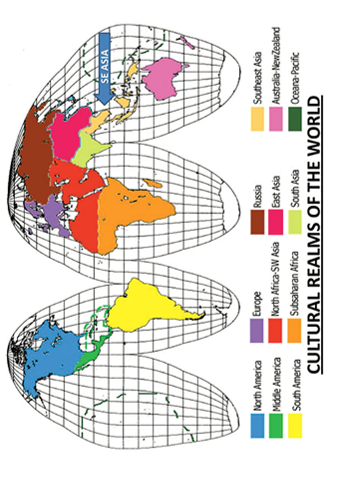
2. The Mongoloid
- They have the folding eye lids, almond shaped eyes, yellowish skin tone, and V shaped cheeks.
- Native Americans and Eskimo are also classified as Mongoloid.
- Compared to the other races, they have the least body hair, least body odour, and smallest limb ratio.
- Their facial structure is likely to adapt cold mild wind. They are living in East Asia.

3. The Caucasoid
- The Caucasoid is known as “white people” characterised by the pointy nose, vertical forehead, pinkish/orange skin tone, visible brow ridge, and colourful eyes/hair.
- Some believe that their light skin tone is meant to receive more sunlight due to Europe’s climate.
- Some believe that their nose structure is meant to keep the nose moisture from getting dried by the wind.
- They are living in Europe and Middle East.
4. Australoid Race
- They have visible eye ridge, wide nose, curly hair, dark skin tone, and short in height.
- Some believe that their visible ridge helps them to eat stiff foods.
- They are living in Australia and Papua New Guinea.
Characteristic of Major Races
| Feature | Caucasoid | Mongoloid | Negroid |
| Skin colour | Pale reddish white to olive brown. | Saffron to Yellow Brown, reddish brown. | Brown to black brown yellow brown. |
| Stature | Medium to Tall. | Medium tall to Medium Short. | Tall to very Short. |
| Face | Narrow to medium broad, tends to high no prognathism | Medium broad to very broad malars high and flat tends to medium high | Medium broad to narrow tends to medium high strong prognathism |
| Head Form | Long-broad and Short Medium, high-very high. | Medium height, predomi¬nantly broad. | Predominantly long, Low height. |
| Hair color | Light blonde to Dark brown, straight to wavy. | Brown to brown black, Straight. | Brown black light curl and wooly. |
| Body Build | Linear to lateral slender to refuge. | Tend to be lateral, some linearity evident. | Tend to be linear and muscular. |
| Nose | Usually high, narrow to medium board. | Low to medium form, medium broad. | Low, medium to very broad. |
| Blood Group | More A than B. | High in B. | High is Rh(D). |
| Eye | Colour: light blue to dark brown , lateral eye – fold occasional | Colour: brown to dark brown , medial epicanthic fold very common | Colour: brown to brown block, vertical eye – fold common |
Ethnicity
- Ethnicity is a concept referring to a shared culture and a way of life.
- This can be reflected in language, religion, material culture such as clothing and cuisine, and cultural products such as music and art.
- Ethnicity is often a major source of social cohesion and social conflict.
- The world is home to thousands of different ethnic groups, from the Han Chinese (the largest ethnic group in the world) to the smallest indigenous groups, some of which include only a few dozen people.
- Almost all of these groups possess a shared history, language, religion, and culture, which provide group members with a common identity.
- India is a unique country with great diversity in ethnicities, race, religion, language, culture, cuisine and in every other aspect of the human society.
- Indian civilization is one of the oldest in the world and primarily consists of the Indo-Aryans of North India and the Dravidians of South India, the people of the Indus Valley Civilization while the former migrated to the country at about 1800 BC.
- As India has such a diverse cultural demographic, it makes sense that the country is also.
Dravidians
- The Dravidian people are any native speakers of the Dravidian languages in the Indian Subcontinent.
- Almost all the Dravidians live in the southern part of India.
- The five major ethnic groups of Dravidian people in India are Tamil, Telugu, Kannada, Malayalam, and Tulu.
- The ancient Indus Valley civilization in India was believed to have been of Dravidian origin in northern India, but then the Dravidian people were pushed south when the Indo- Aryans came in and the Kuru Kingdom in northern Indian arose.
- Later South India was dominated by the three Dravidian kingdoms of the Cheras, Cholas, and the Pandyas.
- These three kingdoms have been shown to sponsor the growth of literature, music, and the arts and to have done extensive trading.
- The three kingdoms also supported and were tolerant of Buddhism, Jainism, and Hinduism.
- The major languages spoken by the Dravidian people are Tamil, Telugu, Kannada, Malayalam, and Brahui.
Religion
- Religion is not a vague fear or unknown powers not the child of terror, but rather a relation of all the members of a community to a power that has the good of the community at heart and protects its law and moral order.
- Religion produces a distinct attitude towards life which affects the further development of the society.
- Indeed most cultural situations show the mutual interaction between religion and socio-economic and politico-cultural factors.
Classification of religion
- Religion may be classified based on the belief in god.
- Monotheistic: the followers of monotheism believe in a single god (Islam, Christianity).
- Polytheistic: the followers of polytheism believe in many gods (Hinduism).
- Another classification is on the basis of areas of origin such as Eastern religion, Western religion, far Eastern religion, African religion, Indian religion, etc. Geographers generally classify religions into following;
- Universalizing religions – Christianity, islam, Buddhism.
- Ethnic religions – Hinduism, shintoism (Japan), Chinese faiths, Judaism.
- Tribal or traditional religions – animism, shamanism, secular (non religious and atheists).
Major religions of the world
- Major religions of the world are classified based on the followers. They are Christianity, Islam, Hinduism, Buddhism, and Judaism.
- Other important religions include Chinese folk religions, Sikhism, Confucianism, Shintoism etc,.
- Christianity is a universal religion which has the largest number of followers in the world.
- They are spread in Europe, Anglo America, Latin America, Africa, Asia and Oceania. Its sacred book is “Bible”.
- Islam is the second largest religion of the world.
- The largest concentration of the Islam is in the South West Asia, Central Asia, South Asia and South East Asia Followed by the North Africa.
- Shia and Sunni are its two main sects. Its sacred book is Kuran.
- Hinduism is the oldest ethnic religion of the world which was founded about 3000 B.C (B.C.E) in India.
- Today it has over 8 million followers in the world but main concentration is in India and Nepal.
- Nearly 99 percent of the total Hindu population is concentrated in south Asia.
- Its sacred books include the Vedas, the Upanishads, the Epics, the Ramayana and Mahabharata, and the Bhagavad Gita.
- Buddhism is also one of the oldest religions of India which was founded by Lord Buddha around 525 B.C (B.C.E).
- Its spread in several Asian countries (China, Myanmar, India, Srilanka, japan, Mangolia, korea and South East Asian countries) due to its liberal philosophy.
- Its two main sects are Hinayana and Mahayana.
- Judaism is the oldest Monotheistic faith which is regarded as the parent of Christianity.
- It originates 4000 years ago in the Middle East. At present it has about 14 million followers living in U.S.A, Europe and Asia.
- Chinese religions include two main beliefs called Confucianism and tao-ism.
- Confucianism was established by Confucious (551-479 B.C (BCE)).
- Taoism was established by Lao Tse (604-517 B.C (BCE)).
- Jainism is also born in India as a reaction to orthodox Hinduism.
- It was founded by Lord Mahavir who was a Contemporary of Lord Buddha.
- Its followers are mostly concentrated in India.
- It is an offshoot of Hinduism which was established in the 15th century by Guru Nanak.
- It remained confined to Punjab state and has accepted Gurumukhi as its language.
Tribal Religions
- Tribal religions are the special forms of ethnic religion. The tribal people are generally in the Neolithic stage of social development.
- Tribal people are strikingly different and diverse in their culture, social and economic life.
- They cherish their own distinct and have maintained a close relationship to the land and natural environment.
- Most of them live according to their traditions and are engaged in food gathering, hunting, fishing, primitive agriculture etc, there are about 300 million indigenous people worldwide, constituting about four percent of the total population of the world living in more than sixty countries.
- Sometimes the tribal people are being termed as the fourth world.
- The first – second and third world believed that “the land belongs to the people” whereas the fourth world believes that “the people belongs to the land”.
Tribal Distribution in world
Some major tribal group of the world particularly who are living and struggling
- Equatorial Forest region: Pigmy, Semang, Sakai, Boro, Papuan, etc.
- Grasslands: Masai, Kyrghizs, etc.
- Tropical deserts: Bedowin, Bushman, Aborigines etc.
- Mountainous region: Bhotia, gujjar, Naga etc.
- Monsoon regions: Gonds, Santhals, Todas, Bhils, etc.
- Arctic cold regions: Eskimo, Lapp, Alute, Chukchi etc.
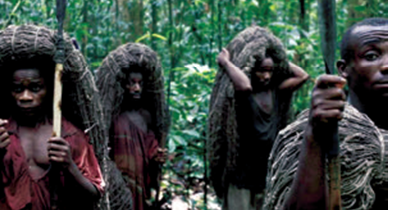
Pigmies
- The pigmies are Negroid people and are also called Negrillos. They are the nearest approximation of human being to animal.
- They are short stature, flat nosed, wooly haired, long headed and black people.
- The average height of men and women are found 150cm.
- So they are also called dwarf. The pigmies are those who live in scattered parts of tropical Central Africa.
- They are found in many sub-groups in the equatorial forest region of Africa mainly in Congo basin 3ºN and 3ºS latitudes along both sides of the equator.
- In addition some groups of Pigmies are also found in the forests of Philippines and New Guinea.
Masai
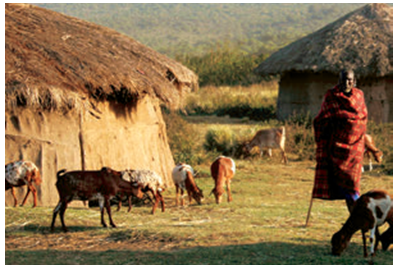
- The Masai of east Africa belong to the pastoral society and are known as the best and most typical cattle herders not only of Africa but also of the world.
- Masai people are tall and slender with ling feet, hands and fingers. Their skin colour ranges from light chocolate to dark brown.
- They have high and long head, thin face and nose. Their lips are less thick than that of Negroid people.
- Masai occupy the interior plateau of the equatorial Africa.
- The territory of the Masai lies between 1ºN and 6ºS latitudes and covers all the rift valleys in this region.
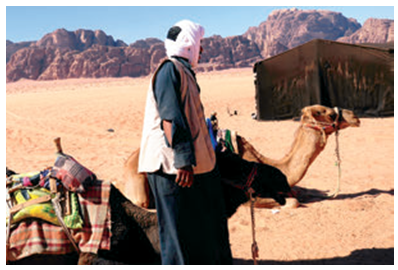
Bedouin
- In Arabic, Bedouin means desert dwellers.
- The Bedouins are most important among the tribal of South West-Asia and North Africa.
- They are pastoral nomads and keep camel, sheep, goats, horse etc.
- The Bedouins occupy the desert areas of the Arabian Peninsula including Saudi Arabia, Yemen, Oman, Syria and Jordan.
- The Bedouins belongs to the mixture of Mediterranean and Armenian races.
- They are medium stature people with long narrow face, prominent nose, dark eyes and hair. Their complexion is wheatish to pale.
Bushman
- Bushman is the tribal people of Kalahari Desert in southern Africa who are still engaged in hunting and gathering economics.
- They are on constant run for both food and water.
- Their homeland Kalahari Desert lies in Botswana, Namibia and southern Angola.
- The bushman territory is a wide plateau about 2000 meters above the sea level with sub tropical climate.
- The bushman are including in the Negroid stock. .
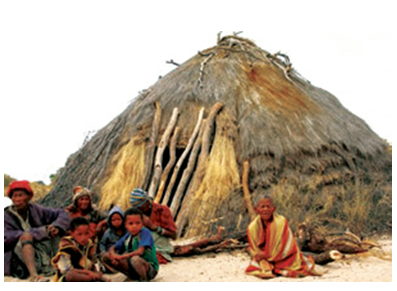
- They are very short in stature and have long head, short and flat ears, and yellowish brown complexion.
- On the whole the Negroid characteristics prevail among the Bushman.
Eskimos
- Eskimos also called Inuits are tribes of tundra cold region in Canadian northland, Alaska, Greenland and north-eastern Siberian coastal region.
- The Eskimos are Mongoloid race.
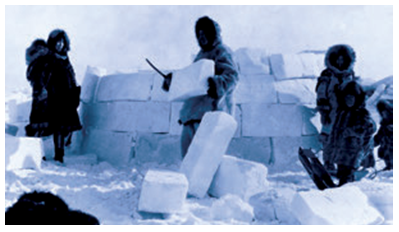
- The main physical characteristics of the Eskimos are short stature, Flat narrow face, small snub nose, yellow –brown complexion and coarse straight black hair.
- Hunting and fishing are the main occupations of the Eskimos.
- They live in igloo and practice hunting way known as Maupak.
- The Eskimos wear clothes of caribous or reindeers skin and other furs.
- Eskimos are migratory by nature and construct ice houses called Igloos.
- For travelling on ice shield the Eskimos use sledge which is usually built either of whale bone or of wood whichever is available.
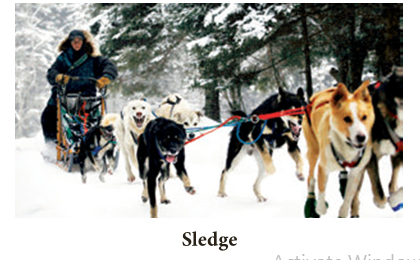
- It is drawn by two or more dogs, caribous or rain deer.
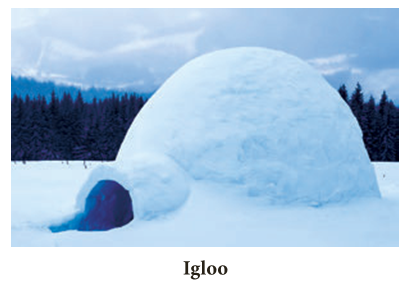
Tribal in India
- India is the home to large number of indigenous people, who are still untouched by the lifestyle of the modern world.
- With more than 84.4 million, India has the largest population of the tribal people in the world.
- These tribal people also known as the adivasis are the poorest in the country, which are still dependent on haunting, agriculture and fishing.
- Some of the major tribal groups in India include Gonds, Santhals, Khasis, Angamis, Bhils, Bhutias and Great Andamanese.
- All these tribal people have their own culture, tradition, language and lifestyle.
- There are more than 50 tribal groups in India.
- Most of the tribal belong basically to the Negrito, Australoid and Mongoloid racial stocks.
Bhils
- Bhils are popularly known as the bow men of Rajasthan.
- They are the most widely distributed tribal groups in India. They form the largest tribe of the whole South Asia.
- Bhils are mainly divided into two main groups the central or pure bills and eastern or Rajput Bhils.
Gonds
- The Gonds are the tribal community mostly found in the Gond forests of the central India.
- They are one of the largest tribal groups in the world.
- Gonds have been largely influenced by the Hindus and for the long time have been practicing the Hindus culture and traditions.
Santhals
- Santhals are the third largest tribe in India.
- They are mostly found in the states of West Bengal, Bihar, Odisha, Jharkhand and Assam.
- They belong to the pre- Aryan period and have been the great fighters from the time of the British.
Munda
- Munda tribe mainly inhabit in the region of Jharkhand, although they are well spread in the states of West Bengal, Chhattisgarh, Odisha and Bihar.
- Munda generally means headman of the village.
- Hunting is the main occupation of the Mundas tribe.
Khasi
- Khasi tribe is mainly found in the Khasi Jaintia hills in Meghalaya and in the states of Punjab, Uttar Pradesh, Manipur, West Bengal and Jammu and Kashmir.
- They form the large part of the population in the state of Meghalaya.
Angami
- Angami tribe belongs to the extreme north eastern part of the country, in the state of Nagaland.
- The total population of the Angamis is around 12 million. They are quite popular for their woodcraft and artwork.
- Sekrenyi is the main festival celebrated among the Angamis in Nagaland
Bhutia
- Bhutia tribes are of the Tibetan origin.
- They migrated to Sikkim around 16th century. In the northern part of the Sikkim they are known as the Lachenpas and Lachungpas.
- Bhutias forms 14% of the total population of Sikkim.
- Losar and Losoong are the main festivals celebrated among the Bhutia tribes.
The Sentinelese tribe, the most dangerous tribe in the world!
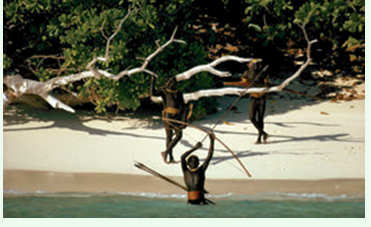
- Located far into Andaman and Nicobar Islands, the Bay of Bengal in the Indian Ocean, North Sentinel Island is one of the most isolated places on earth.
- This remote island is home to the Sentinelese tribe, the most dangerous tribe in the world.
- The Sentinelese are hunter- gatherers, as agriculture is not known to them. Their diet consists mainly of coconuts and fish that can be found in the shallow waters around their shores.
- The Sentinelese would be described as Stone Age people.
- The women wear fibre strings tied around their waists, necks and heads.
- The men also wear necklaces and headbands, but with a thicker waist belt.
- The men carry spears, bows and arrows.
- Sometimes the Sentinelese appeared to make friendly gestures at others they would take the gifts into the forest and then fire arrows at the contact party.
- The population of North Sentinel Island is estimated at 250 individuals.
- The Sentinelese do not want help from outsiders.
Chenchu
- Chenchu inhabit in the Nallamalai hills, which have been the part of the Nagarjuna Sagar Tiger Sanctuary for centuries in Andhra Pradesh, India.
- They are mainly found in the districts of Mahabubnagar, Nalgonda, Praksham, Guntur, and Kurnool.
Great Andamanese
- Great Andamanese is the Negrito tribe inhabitant in the Andaman group of Islands.
- They form the largest population among the other tribes found in these islands.
- According to the census the population of Great Andamanese is now limited to few individuals.
Tribals in Tamilnadu
- Tribes of Tamil Nadu are concentrated mainly in the district of Nilgiris.
- Of all the distinct tribes, the Kodas, the Thodas, the Irulas, the Kurumbas and the Badagas form the larger groups, who mainly had a pastoral existence.
- Other tribes include, Kattunayakan and Paliyan amongst others.
- According to census 2011, tribal population in Tamil Nadu is 7, 94,697.
- There are around 38 tribes and sub-tribes in Tamil Nadu.
- The tribal people are predominantly farmers and cultivators and they are much dependant on the forest lands.
Toda:
- Men from the family of the tribes are occupied in milking and grazing their large herds of buffaloes.
- Their settlements are known as ‘Munds’. They do not worship any god and their consciousness is cosmic.
- They live in Nilgiris. Today, there are about a thousand Todas left.
Badaga:
- The Badagas belong to the backward class and are not classified as tribal.
- They are an agricultural community, dwelling in the higher plateau of the Nilgiris district in the state of Tamil Nadu.
- They are engaged in tea cultivation and potato growing.
- They form the largest group of tribes and boast a rich oral tradition of Folk tales, songs and poetry.
- These tribes are Hindu and belong to the shiva sect.
Kota:
- The Kotas are mainly concentrated in the Tiruchigadi area in the Nilagiri hills.
- They are distinguished by their colourful Folk dances and are basically musicians, who play at Badaa funerals.
- They are mainly engaged in producing handicrafts. These tribes of Tamil Nadu are expert iron smiths, potters and carpenters.
- In order to maintain distance and status in society, the Kotas implement elaborate tattoos.
Kurumbas:
- The Kurumbas tribes of this state inhabit the intermediate valleys and forests in Villages and were known for their black magic and witchcraft in the past.
- Their way of living today has changed from their original gathering and hunting existence to working in Coffee and Tea plantations as labourers.
- Kurumbas are perhaps the only main caste in southern India that has a specialized and distinctive Kurumbas Language.
Irula:
- The Irula tribes of Tamil Nadu occupy the lower slopes and forests at the base of the Nilgiri Hills.
- They constitute the second largest group of tribes after the Badagas and are similar to the Kurumbas in many ways.
- This tribe produces honey, fruits, herbs, roots, gum, dyes etc., and trades them with the people in the plains.
- In the recent times the Irulas help in catching snakes and collect the snake venom.
Paliyan:
- They are of the food gathering communities of Tamil Nadu.
- It is believed that the Paliyan originally belonged to the Palani hills.
- They are distributed in the districts of Madurai, Tanjavour, Pudukkottai, Tirunelveli and Coimbatore.
Language
- Language is an identification mark for different cultures.
- Because language is essential to communication, it strongly influences the sort of political, social and economic we create.
- As a result, economic and religious system frequently follows patterns of language distribution and political borders quite often parallel linguistic boundaries.
- In modern times linguistic diffusion has been facilitated by trade, tourism, media and international organizations.
- It has helped in the development of the linguistic pluralism.
- The greatest linguistic diversity is attributed to heterogeneous societies.
Major linguistic Families of the World
- The classification of languages by origin and historical development is known as a genetic classification.
- The languages which are the descendants of common ancestral language are called proto – language.
- G.L. Trage has classified the languages of the world into 7 linguistic phylum and 30 linguistic families.
- Linguistic families are further classified in to sub families of languages, which denote major languages.
- Indo-European – a. Indo-Iranian, b. Latin or Romantic, c. Germanic, d. Balto –Slavic, e. Celtic, f. Hellenic
- Sino-Tibetan – a. Chinese, b. Tibetan, c. Burman
- Afro-Asiatic – a. Semitic, b. Egyptian, c. Cushitic, d. Chadic
- African – a. Niger – Congo (Atlantic, Voltaic, Benu-Nagar) b. Sudanic (Chari-Nile, Saharan,) c. Click Languages (Khoisan)
- Ural-Altaic – a. Finno-Igric, b. Turkic, c. Mangolic, d. Tunguzic
- Dravidian– malayo – Polynesian- – a. Dravidian, b. Malayan, c. Melanesian, d. Micronesian, e. Polynesian, f. Austro- Asiatic.
- Palaeo Asiatic– a.Yukaghir
Major Languages of India
- India has a rich Linguistic heritage and has heterogeneous ethnic and social groups, which have their own languages and dialects.
- According to census of India 1961, there were 187 languages spoken by various sections of Indian society.
- 23 major languages were spoken by about 97 percent population of the country.
- 22 languages excluding English are mentioned in the eighth schedule of the constitution of India as follows; Kashmiri, Punjabi, Hindi, Urdu, Bengali, Assamese, Guajarati, Marathi, Kannada, Tamil, Telugu, Malayalam, Sindhi, Sanskrit, Oriya, Nepali, Kongani, Manipuri, Bodo, Dogri, Maithili and Santali of these languages, 14 were initially included in the Constitution.
- Subsequently, Sindhi was added in 1967 by 21st constitutional amendment act; Konkani, Manipuri and Nepali were added in 1992 by 71st Constitutional Amendment Act; and Bodo, Dogri, Maithili and Santali were added in 2003 by 92nd Constitutional Amendment Act.
- Indian Languages belong mainly to four linguistic families
- Austric – Munda, Mon-Khmer
- Dravidan – Tamil, Telugu, Kannada, Malayalam, Gondi, kurukh, orean, etc.
- Sino– Tibetan- Bodo, Karen, Manipuri, etc.
- Indo – Aryan – Hindi, Urdu, Sans.
Dialect
- A distinct linguistic form peculiar to a region or social group but which nevertheless, can be understood by speakers of other forms of the same language.
- The two main types of dialects are the geographic dialect, spoken by the people of the same area or locality, and the social dialect used by people of the same social class, educational level or occupational group.
Major dialects in India
- More than 40 languages or dialects in India are considered to be endangered and are believed to be heading towards extinction as only a few thousand people speak them officials said.
- According to a report of the census Directorate, there are 22 scheduled languages and 100 non –scheduled languages in India.
- The scheduled languages are 11 from Andaman and Nicobar, Seven from Manipur and Four from Himachal Pradesh.
- There are 42 languages spoken by less than 10,000 people. Some other languages also are in endangered position in India.
Major dialects in Tamil Nadu
- Tamil is an interesting language with a range of native dialects.
- The language has several charming improvisations in different regions of the state.
- Many people are familiar with the old and familiar dialects of Tamil such as Chennai, Coimbatore, Madurai and Tirunelveli.
Political Geography – Concept of Nation and State
Nation
- A nation is a group of people who see themselves as a cohesive and coherent unit based on shared cultural or historical criteria.
- Nations are socially constructed units, not given by nature.
- Their existence, definition, and members can change dramatically based on circumstances.
- Nations in some ways can be thought of as “imagined communities” that are bound together by notions of unity that can pivot around religion, ethnic identity, language, cultural practice and so forth.
State
- A State is an independent, sovereign government exercising control over a certain spatially defined and bounded area, whose borders are usually clearly defined and internationally recognized by other states.
Nation-State
- The nation state is a system of organization defined by geography, politics and culture.
- The nation is cultural identity that is shared by the people, and the state is the governing administration.
- A nation state must have a shared national identity, physical borders, and a single government.
- A nation-state is a political unit with a well- defined territory, inhabited by a people who are well-organised, possess sufficient powers and consider themselves to be a nation by virtue of certain binding factors which may be emotional and which are reflected in law and governance.
Frontiers and Boundaries
Frontiers:
- International frontiers and boundaries separate land, rivers and lakes subject to different sovereignties.
- In 1900 frontiers had almost disappeared and had been replaced by boundaries that are lines.
- A Frontier is a politico geographical area, lying beyond defined borders of a political unit into which expansion could take place
Types of Boundaries
- Boundaries can be classified according to their relationship with the cultural landscape.
- Some boundaries were established prior to the permanent occupation of areas by the present inhabitants.
- In some cases patterns of settlement were already developing so that the boundary ultimately established has a different relationship to the cultural realities of the area involved.
- This classification is known as the functional or genetic classification of boundaries.
Different between Frontier and Boundary
| Frontier | Boundary |
| 1. Natural | 1. Mostly Anthropogenic |
| 2. Areal Concept | 2. Linear Concept |
| 3. Frontiers have no political dispute | 3. Boundaries vary often disputable by the rival nations |
| 4. Frontier generally has mountainous area, desert, marshes, etc. Thus, inhabitable | 4. But boundaries have no such criteria |
| 5. Frontiers are dynamic | 5. Boundaries are static because once fixed, they hardly change |
Boundaries:
- A boundary is a line demarcating the recognised limit of an established political unit, administrative region or geographical region e. g a state, country or district.
Genetic Classification of the boundaries
1. Antecedent Boundaries
- The boundaries drawn before the cultural- political realm. Such boundaries were non-contentious. E .g, N. Africa and the state boundaries of USA.
2. The Subsequent Boundaries
- When the cultural realms are fully developed & political boundaries are contentious.
- Such boundaries are irregular or amorphic boundaries.
- E.g. the countries of Europe.
3. Superimposed Boundaries
- When a political boundary divides a homogenous cultural region and across the boundary the people with similar ethnicity are found. E.g. Pok
4. Relict Boundaries
- Historical boundaries which only exist in the books. E .g. Persia, the boundary between east & West Germany.
Geopolitics: Global Strategic views
- The study of the way a country’s size, position, etc, influence its power and its relationships with other countries.
- Political activity is influenced by the physical features of a country or area of the world.
- Geo politics is concerned with how geographical factors including territory, population, strategic location, and natural resources endowments as modified by economics and technology affect the relations between states and the struggle forward domination.
- It is battle between land power and sea power which is going to lead the world continents by one.
- Mackinder described the political history of the world as continuous struggle between land and sea powers.
- According to him, the Columbian era of sea powers, which gave Europe its pivotal position for four centuries is coming to an end.
- And in the struggle between land and sea powers, the ultimate victory is going to be of one possessing land powers. He divided the earth into 3 tiers.
- The Heartland – area of interior and Arctic drainage in the Eastern Europe, covered by mountains on three sides and Arctic in north. This is a natural fortress on earth, inaccessible to sea powers.
- The Inner or Marginal Crescent – area of Europe and Asia adjoining the Heartland and Africa, north of Sahara.
- The Outer or Insular Crescent – It includes North and South America, Africa (south of Sahara) and Australia.
- Besides, it also includes the Great Britain and Japan because of their insularity from Eurasia.
- According to Mackinder, one with control over Heartland will be in an unstoppable position to rule the world.
- Heartland, with its agricultural and industrial resources would conquer the inner crescent and Outer crescent would follow later.
Mackinder’s Theory
- He conceptualized his theory as:
- Who rules East Europe commands the Heartland. Who rules Heartland commands World Island.
- Who rules World Island commands the World.
- Mackinder later argued that key to control Heartland lays in Eastern Europe, reflecting a powerful strand of pre and post- Versailles geographical thinking concerning the news to separate the powerful states of Germany and Russia by the creation of ‘buffer states’.
- Influence – His theory was put to test during the World War II when the Heartland could become the power centre of the world if either Germany unites with Russia or China or Japan thrashes Russia.
- But the shattering defeat of Germany turned Heartland into a power vacuum.
- The area highlighted in red is the heartland, blue is rim land and the encircled area is the world island.
- The heartland is inaccessible from top because North Sea, Norwegian Sea, Barents Sea, Kara Sea, Laptev Sea, East Siberian Sea are all frozen throughout the year.
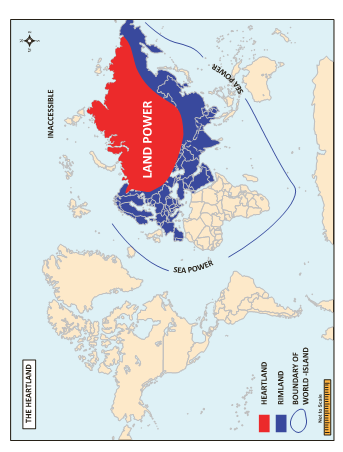
- The hearland is inaccesible from the bottom because of Middle Eastern desert, Iranian Plateau, Himalayas, Plateau’s of Tibet and Siberian mountains.
- This makes heartland immune to any conquests from any other side than Eastern Europe.
- The only gateway to the heartland is through Eastern Europe.
- So, protecting one gateway would be far easier than protecting the whole land.
- Moreover, the heartland was self sufficient with most of the resources and wasn’t dependent on trade from outside world.
- So, Mackinder believed that the one who controls the heartland would be able to control the Rimland and as a result the world-Island, and the one, who rules the world Island, would rule the world.
- Although this theory made sense at that time (1904), when there was no significant aviation and naval power, it does not make much sense now.
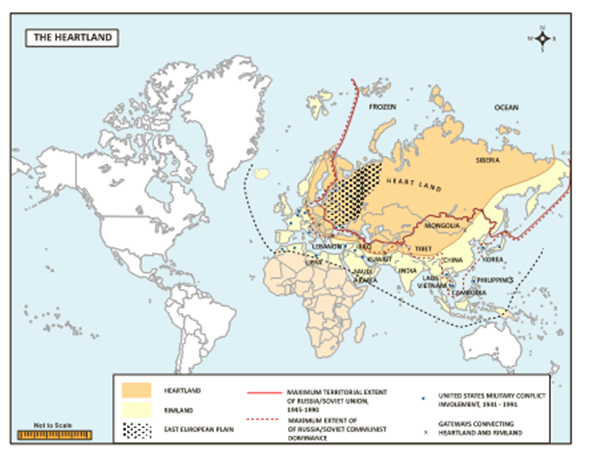
21st Century Geopolitics of the multipolar world order
- To put it succinctly, the unipolar world is characterized by the US’ predominant hegemony in a wide variety of spheres, whether exercised directly through unilateral initiatives or indirectly (“Lead From Behind”) through its regional and institutional partners.
- The Multipolar forces in the world are working to replace the US-led international order with a diversified array of multiple stakeholders in order to bring balance to International Affairs.
- Importantly, they seek to do this through progressively reforming international institutions such as the UN, IMF, World Bank, and others, as well as creating their own counterparts to some of them like the BRICS New Development Bank or outright forming entirely new and unprecedented organizations like the SCO.
- One of the latest proposals has been to broaden the BRICS format through what has now been called the “BRICS-Plus” strategy, which essentially seeks to have each of the five member states encourage multilateral cooperation between each other’s respective regional integration organizations.
- As Russian Valdai Club expert Yaroslav Lissovolik describes it, this could see Mercosur, the SADC, the Eurasian Economic Union, SCO, SAARC, and ASEAN all cooperating with one another in changing the world order.
Missile Defense Shield, Prompt Global Strike, and the Naval Race
- The basis of American control over the world is through economic means as enforced by military ones.
- In certain cases, though, the US is unable to directly attack its rivals such as Russia and China without suffering unacceptable damage through a nuclear second strike, ergo why Washington is pushing to build anti-missile installations all around Eurasia in order to ring in these Great Powers and diminish their most credible deterrent capability.
- Complementary with this are the US’ space weapons, whether based in this theatre (X37-B and the policy of “Prompt Global Strike”) or directed towards it (anti-satellite weapons, whether kinetic such as missiles or non-kinetic like lasers).
- Neither the US’ missile shields nor its space-related weaponry are sufficient enough for ensuring that the country is defended from submarine-launched ballistic missiles, which form a crucial component of any country’s nuclear triad.
- This explains why there’s an ongoing naval race across the world as the US seeks to ensure its dominance in the high seas in the face of rising competition from Russia, China, and others.
- The global ocean is also important for another reason as well, and this one relates back to the economic basis of American dominance over the world.
- China depends on the international waterways for the vast majority of its trade, which makes it inordinately vulnerable to any US efforts to block certain chokepoints such as the Strait of Malacca and Suez Canal.
OBOR’s Global Reorganization
- Understanding the sudden systemic- shaking consequences that any hostile action like this could inflict for China’s domestic socio-economic stability, the People’s Republic prudently foresaw the need to pioneer ambitious trans-continental trade routes to its crucial European partner, as well as secure the Sea Lines Of Communication (SLOC) along its existing maritime ones in order to safeguard its access to the growing economics of Africa.
- The latter are exceptionally important nowadays because their growth is expected to allow Beijing to relieve itself of its industrial overproduction so long as it can succeed in building up these marketplaces and stabilizing them.
- As for the Western Hemisphere, China wants to increase its soft presence here as a means of competing with the US and asymmetrically countering America’s moves in the South China Sea.
- Altogether, the above stratagem explains the essence of China’s One Belt One Road (OBOR) global vision of New Silk Road connectivity, which is designed to transform the world’s trading networks so as to facilitate the transition from a unipolar American-led international order to a diversified Multipolar one safeguarded by a host of Great Powers.
- It also, however, provides the blueprint for how the US will oppose the greatest threat thus far to its worldwide hegemony, as all that Washington has to do is encourage identity-centric Hybrid Wars in the geostrategic transit states along these corridors in order to disrupt, control, or influence them in ways which remove their Multipolar game-changing impact.
Geopolitics and the New World Order
- The global elite–leading academics, intellectuals, foreign policy analysts, foundation heads and corporate power brokers, as well as many Western leaders–may largely have forgotten about it.
- But what we’re witnessing now is geography’s revenge in the East-West struggle for control of the buffer state of Ukraine, in the post–Arab Spring fracturing of artificial Middle Eastern states into ethnic and sectarian fiefs and in the unprecedented arms race being undertaken by East Asian states as they dispute potentially resource-rich waters.
- Technology hasn’t negated geography it has only made it more precious and claustrophobic.
- Whereas the West has come to think about international relations in terms of laws and multinational agreements, most of the rest of the world still thinks in terms of deserts, mountain ranges, all-weather ports and tracts of land and water.
- The world is back to the maps of elementary school as a starting point for an understanding of history, culture, religion and ethnicity–not to mention power struggles over trade routes and natural resources.
- Europe’s modern era is supposed to be about the European Union triumphing over the bonds of blood and ethnicity, building a system of laws from Iberia to the Black Sea–and eventually from Lisbon to Moscow.
- But the E.U.’s long financial crisis has weakened its political influence in Central and Eastern Europe.
- And while its democratic ideals have been appealing to many in Ukraine, the dictates of geography make it nearly impossible for that nation to reorient itself entirely toward the West.
- Russia is still big, and Russia is still autocratic after all it remains a sprawling and insecure land power that has enjoyed no cartographic impediments to invasion from French, Germans, Swedes, Lithuanians and Poles over the course of its history.
- The southern Crimean Peninsula is still heavily ethnic Russian, and it is the home of Russia’s Black Sea fleet, providing Russia’s only outlet to the Mediterranean.
- In short, Russia will use every geographical and linguistic advantage to weaken Ukraine as a state.
- Ukraine is simply located too far east, and is too spatially exposed to Russia, for it ever to be in the interests of any government in Moscow–democratic or not–to allow Ukraine’s complete alignment with the West.
- To live in a world where geography is respected and not ignored is to understand the constraints.
- Many obstacles simply cannot be overcome. That is why the greatest statesmen work near the edges of what is possible.
- Geography establishes the broad parameters– only within its bounds does human agency have a chance to succeed.
- While our foreign policy must be morally based, the analysis behind it must be cold- blooded, with geography as its starting point.
- In geopolitics, the past never dies and there is no modern world.
MORE TO KNOW:
Brahui
- Arabic script Brahui is the only Dravidian language which is not known to have been written in a Brahmi based script, instead, it has been written in the Arabic script since the second half of the 20th century in Iran Pakistan and Afghanistan.
Tribal Population
- The percentage of tribal to total population is as high as over 90 percent in Greenland, 66 percent in Bolivia and 40 percent in Peru.
- In India share of tribal people to total population is 8.2 percent.
Language Extinction
- As many as half of the world’s 7,000 languages are expected to be extinct by the end of this century; it is estimated that one language dies out every 14 days.
The Longest- Surviving Classical Language
- Tamil is one of the longest- surviving classical languages in the world.
- The earliest period of Tamil literature, Sangam literature, is dated from 300 BC (BCE) – AD (CE) 300.
- It has the oldest extant literature among Dravidian languages.
UNESCO’S five levels of language risk:
- Safe: Widely spoken Vulnerable: Not spoken by children outside the home (600 languages)
- Definitely endangered: Children not speaking (646 languages)
- Severely endangered: Only spoken by oldest generations (527 languages)
- Critically endangered: Spoken by only a few members of the oldest generation, often semi-speakers (577 languages)
Vaishali
- Vaishali was established as a republic by the 6th century B.C (BCE), prior to the birth of Gautama Buddha in 563 B.C (BCE), making it the world’s first republic.
Longest land border sharing countries:
- China has the maximum number of neighbours touching its border.
- The 14 countries touching its border are: India, Pakistan, Afghanistan, Tajikistan, Kyrgyzstan, Kazakhstan, Mongolia, Russia, North Korea, Vietnam, Laos, Myanmar, Bhutan and Nepal
- Canada, the world’s second largest country, shares the longest international land border with the United States.
- The Canada- US land border is 8,893 km long.
